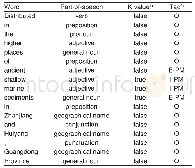《Table 3 The effects of parent materials on soil nutrients1)》
 提示:宽带有限、当前游客访问压缩模式
提示:宽带有限、当前游客访问压缩模式
本系列图表出处文件名:随高清版一同展现
《"Spatial variability of soil total nitrogen,phosphorus and potassium in Renshou County of Sichuan Basin,China"》
1) Q2,the Quaternary period;K1,the Cretaceous period;J1,2,3,the Jurassic period;T3,the Triassic period.2) TN,total nitrogen;TP,total phosphorus;TK,total potassium.*,significant correlation coefficients at P<0.05;**,significant correlation coeffi
Parent materials The results of one-way ANOVA showed statistically significant differences for TP and TK content among the four types of parent materials,while there was no significant difference for TN content among the parent materials(Table 3).This indicated that parent materials had significant impacts on the spatial distributions of TP and TK but not on TN.Soils formed from J1,2,3 purple shale had the highest mean value of TP content,followed by soils formed from K1 purple shale and Q2 alluvial and fluviological deposits,and the lowest mean value of TP content was found in soils from T3 purple shale.The highest mean value of TK content was also found in soils formed from J1,2,3purple shale but the lowest mean value appeared in soils formed from Q2 alluvial and fluviological deposits.Parent materials can affect the supply of soil nutrient elements by determining soil composition and formation(Zhang et al.2016).Similarly,other studies also found different soil nutrient levels from diverse parent materials(Kooijman et al.2005;Mayes et al.2014).The differences of TP and TK contents among the parent materials here were relative to the contents of the soil nutrient elements of the parent materials such as the mineral composition(He 2003).The content of potassium oxide(K2O)and phosphorus pentoxide(P2O5)of J1,2,3 purple shale was much higher than that of other purple shale in this purple area(He 2003),which resulted in higher TP and TK contents in soils formed from J1,2,3 purple shale.
| 图表编号 | XD0047430200 严禁用于非法目的 |
|---|---|
| 绘制时间 | 2019.02.20 |
| 作者 | GAO Xue-song、XIAO Yi、DENG Liang-ji、LI Qi-quan、WANG Chang-quan、LI Bing、DENG Ou-ping、ZENG Min |
| 绘制单位 | College of Resources, Sichuan Agricultural University、College of Resources, Sichuan Agricultural University、College of Resources, Sichuan Agricultural University、College of Resources, Sichuan Agricultural University、College of Resources, Sichuan Agricultu |
| 更多格式 | 高清、无水印(增值服务) |
查看“Table 3 The effects of parent materials on soil nutrients1)”的人还看了
-

- Table 9 The performance of parent material value extraction for the descriptive text of soil profiles with the condition
-

- Table 8 The performance of parent material value extraction for the descriptive text of soil types with the conditional





